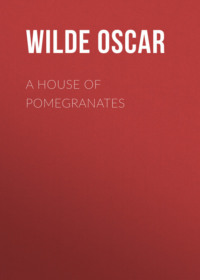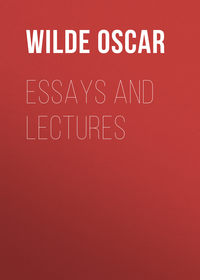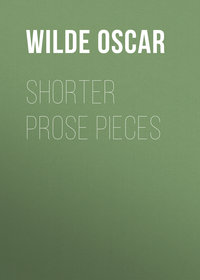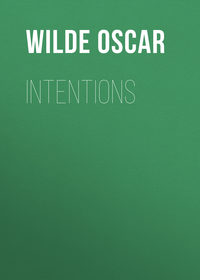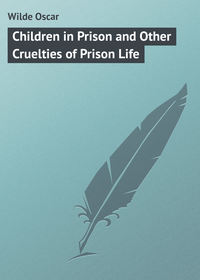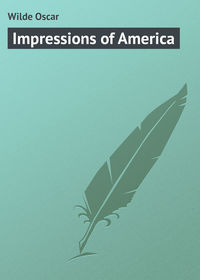 полная версия
полная версияMiscellanies
Mr. Eugene Benson, one of the most cultured of those many Americans who seem to have found their Mecca in modern Rome, has sent a picture of Narcissus, a work full of the true Theocritean sympathy for the natural picturesqueness of shepherd life, and entirely delightful to all who love the peculiar qualities of Italian scenery. The shadows of the trees drifting across the grass, the crowding together of the sheep, and the sense of summer air and light which fills the picture, are full of the highest truth and beauty; and Mr. Forbes-Robertson, whose picture of Phelps as Cardinal Wolsey has just been bought by the Garrick Club, and who is himself so well known as a young actor of the very highest promise, is represented by a portrait of Mr. Hermann Vezin which is extremely clever and certainly very lifelike. Nor amongst the minor works must I omit to notice Miss Stuart-Wortley’s view on the river Cherwell, taken from the walks of Magdalen College, Oxford, – a little picture marked by great sympathy for the shade and coolness of green places and for the stillness of summer waters; or Mrs. Valentine Bromley’s Misty Day, remarkable for the excellent drawing of a breaking wave, as well as for a great delicacy of tone. Besides the Marchioness of Waterford, whose brilliant treatment of colour is so well known, and Mr. Richard Doyle, whose water-colour drawings of children and of fairy scenes are always so fresh and bright, the qualities of the Irish genius in the field of art find an entirely adequate exponent in Mr. Wills, who as a dramatist and a painter has won himself such an honourable name. Three pictures of his are exhibited here: the Spirit of the Shell, which is perhaps too fanciful and vague in design; the Nymph and Satyr, where the little goat-footed child has all the sweet mystery and romance of the woodlands about him; and the Parting of Ophelia and Laertes, a work not only full of very strong drawing, especially in the modelling of the male figure, but a very splendid example of the power of subdued and reserved colour, the perfect harmony of tone being made still more subtle by the fitful play of reflected light on the polished armour.
I shall reserve for another notice the wonderful landscapes of Mr. Cecil Lawson, who has caught so much of Turner’s imagination and mode of treatment, as well as a consideration of the works of Herkomer, Tissot and Legros, and others of the modern realistic school.
Note. – The other notice mentioned above did not appear.
L’ENVOI
An Introduction to Rose Leaf and Apple Leaf by Rennell Rodd, published by J. M. Stoddart and Co., Philadelphia, 1882.
Amongst the many young men in England who are seeking along with me to continue and to perfect the English Renaissance —jeunes guerriers du drapeau romantique, as Gautier would have called us – there is none whose love of art is more flawless and fervent, whose artistic sense of beauty is more subtle and more delicate – none, indeed, who is dearer to myself – than the young poet whose verses I have brought with me to America; verses full of sweet sadness, and yet full of joy; for the most joyous poet is not he who sows the desolate highways of this world with the barren seed of laughter, but he who makes his sorrow most musical, this indeed being the meaning of joy in art – that incommunicable element of artistic delight which, in poetry, for instance, comes from what Keats called the ‘sensuous life of verse,’ the element of song in the singing, made so pleasurable to us by that wonder of motion which often has its origin in mere musical impulse, and in painting is to be sought for, from the subject never, but from the pictorial charm only – the scheme and symphony of the colour, the satisfying beauty of the design: so that the ultimate expression of our artistic movement in painting has been, not in the spiritual visions of the Pre-Raphaelites, for all their marvel of Greek legend and their mystery of Italian song, but in the work of such men as Whistler and Albert Moore, who have raised design and colour to the ideal level of poetry and music. For the quality of their exquisite painting comes from the mere inventive and creative handling of line and colour, from a certain form and choice of beautiful workmanship, which, rejecting all literary reminiscence and all metaphysical idea, is in itself entirely satisfying to the æsthetic sense – is, as the Greeks would say, an end in itself; the effect of their work being like the effect given to us by music; for music is the art in which form and matter are always one – the art whose subject cannot be separated from the method of its expression; the art which most completely realises for us the artistic ideal, and is the condition to which all the other arts are constantly aspiring.
Now, this increased sense of the absolutely satisfying value of beautiful workmanship, this recognition of the primary importance of the sensuous element in art, this love of art for art’s sake, is the point in which we of the younger school have made a departure from the teaching of Mr. Ruskin, – a departure definite and different and decisive.
Master indeed of the knowledge of all noble living and of the wisdom of all spiritual things will he be to us ever, seeing that it was he who by the magic of his presence and the music of his lips taught us at Oxford that enthusiasm for beauty which is the secret of Hellenism, and that desire for creation which is the secret of life, and filled some of us, at least, with the lofty and passionate ambition to go forth into far and fair lands with some message for the nations and some mission for the world, and yet in his art criticism, his estimate of the joyous element of art, his whole method of approaching art, we are no longer with him; for the keystone to his æsthetic system is ethical always. He would judge of a picture by the amount of noble moral ideas it expresses; but to us the channels by which all noble work in painting can touch, and does touch, the soul are not those of truths of life or metaphysical truths. To him perfection of workmanship seems but the symbol of pride, and incompleteness of technical resource the image of an imagination too limitless to find within the limits of form its complete expression, or of a love too simple not to stammer in its tale. But to us the rule of art is not the rule of morals. In an ethical system, indeed, of any gentle mercy good intentions will, one is fain to fancy, have their recognition; but of those that would enter the serene House of Beauty the question that we ask is not what they had ever meant to do, but what they have done. Their pathetic intentions are of no value to us, but their realised creations only. Pour moi je préfère les poètes qui font des vers, les médecins qui sachent guérir, les peintres qui sachent peindre.
Nor, in looking at a work of art, should we be dreaming of what it symbolises, but rather loving it for what it is. Indeed, the transcendental spirit is alien to the spirit of art. The metaphysical mind of Asia may create for itself the monstrous and many-breasted idol, but to the Greek, pure artist, that work is most instinct with spiritual life which conforms most closely to the perfect facts of physical life also. Nor, in its primary aspect, has a painting, for instance, any more spiritual message or meaning for us than a blue tile from the wall of Damascus, or a Hitzen vase. It is a beautifully coloured surface, nothing more, and affects us by no suggestion stolen from philosophy, no pathos pilfered from literature, no feeling filched from a poet, but by its own incommunicable artistic essence – by that selection of truth which we call style, and that relation of values which is the draughtsmanship of painting, by the whole quality of the workmanship, the arabesque of the design, the splendour of the colour, for these things are enough to stir the most divine and remote of the chords which make music in our soul, and colour, indeed, is of itself a mystical presence on things, and tone a kind of sentiment.
This, then – the new departure of our younger school – is the chief characteristic of Mr. Rennell Rodd’s poetry; for, while there is much in his work that may interest the intellect, much that will excite the emotions, and many-cadenced chords of sweet and simple sentiment – for to those who love Art for its own sake all other things are added – yet, the effect which they pre-eminently seek to produce is purely an artistic one. Such a poem as The Sea-King’s Grave, with all its majesty of melody as sonorous and as strong as the sea by whose pine-fringed shores it was thus nobly conceived and nobly fashioned; or the little poem that follows it, whose cunning workmanship, wrought with such an artistic sense of limitation, one might liken to the rare chasing of the mirror that is its motive; or In a Church, pale flower of one of those exquisite moments when all things except the moment itself seem so curiously real, and when the old memories of forgotten days are touched and made tender, and the familiar place grows fervent and solemn suddenly with a vision of the undying beauty of the gods that died; or the scene in Chartres Cathedral, sombre silence brooding on vault and arch, silent people kneeling on the dust of the desolate pavement as the young priest lifts Lord Christ’s body in a crystal star, and then the sudden beams of scarlet light that break through the blazoned window and smite on the carven screen, and sudden organ peals of mighty music rolling and echoing from choir to canopy, and from spire to shaft, and over all the clear glad voice of a singing boy, affecting one as a thing over-sweet, and striking just the right artistic keynote for one’s emotions; or At Lanuvium, through the music of whose lines one seems to hear again the murmur of the Mantuan bees straying down from their own green valleys and inland streams to find what honeyed amber the sea-flowers might be hiding; or the poem written In the Coliseum, which gives one the same artistic joy that one gets watching a handicraftsman at his work, a goldsmith hammering out his gold into those thin plates as delicate as the petals of a yellow rose, or drawing it out into the long wires like tangled sunbeams, so perfect and precious is the mere handling of it; or the little lyric interludes that break in here and there like the singing of a thrush, and are as swift and as sure as the beating of a bird’s wing, as light and bright as the apple-blossoms that flutter fitfully down to the orchard grass after a spring shower, and look the lovelier for the rain’s tears lying on their dainty veinings of pink and pearl; or the sonnets – for Mr. Rodd is one of those qui sonnent le sonnet, as the Ronsardists used to say – that one called On the Border Hills, with its fiery wonder of imagination and the strange beauty of its eighth line; or the one which tells of the sorrow of the great king for the little dead child – well, all these poems aim, as I said, at producing a purely artistic effect, and have the rare and exquisite quality that belongs to work of that kind; and I feel that the entire subordination in our æsthetic movement of all merely emotional and intellectual motives to the vital informing poetic principle is the surest sign of our strength.
But it is not enough that a work of art should conform to the æsthetic demands of the age: there should be also about it, if it is to give us any permanent delight, the impress of a distinct individuality. Whatever work we have in the nineteenth century must rest on the two poles of personality and perfection. And so in this little volume, by separating the earlier and more simple work from the work that is later and stronger and possesses increased technical power and more artistic vision, one might weave these disconnected poems, these stray and scattered threads, into one fiery-coloured strand of life, noting first a boy’s mere gladness of being young, with all its simple joy in field and flower, in sunlight and in song, and then the bitterness of sudden sorrow at the ending by Death of one of the brief and beautiful friendships of one’s youth, with all those unanswered longings and questionings unsatisfied by which we vex, so uselessly, the marble face of death; the artistic contrast between the discontented incompleteness of the spirit and the complete perfection of the style that expresses it forming the chief element of the æsthetic charm of these particular poems; – and then the birth of Love, and all the wonder and the fear and the perilous delight of one on whose boyish brows the little wings of love have beaten for the first time; and the love-songs, so dainty and delicate, little swallow-flights of music, and full of such fragrance and freedom that they might all be sung in the open air and across moving water; and then autumn, coming with its choirless woods and odorous decay and ruined loveliness, Love lying dead; and the sense of the mere pity of it.
One might stop there, for from a young poet one should ask for no deeper chords of life than those that love and friendship make eternal for us; and the best poems in the volume belong clearly to a later time, a time when these real experiences become absorbed and gathered up into a form which seems from such real experiences to be the most alien and the most remote; when the simple expression of joy or sorrow suffices no longer, and lives rather in the stateliness of the cadenced metre, in the music and colour of the linked words, than in any direct utterance; lives, one might say, in the perfection of the form more than in the pathos of the feeling. And yet, after the broken music of love and the burial of love in the autumn woods, we can trace that wandering among strange people, and in lands unknown to us, by which we try so pathetically to heal the hurts of the life we know, and that pure and passionate devotion to Art which one gets when the harsh reality of life has too suddenly wounded one, and is with discontent or sorrow marring one’s youth, just as often, I think, as one gets it from any natural joy of living; and that curious intensity of vision by which, in moments of overmastering sadness and despair ungovernable, artistic things will live in one’s memory with a vivid realism caught from the life which they help one to forget – an old grey tomb in Flanders with a strange legend on it, making one think how, perhaps, passion does live on after death; a necklace of blue and amber beads and a broken mirror found in a girl’s grave at Rome, a marble image of a boy habited like Erôs, and with the pathetic tradition of a great king’s sorrow lingering about it like a purple shadow, – over all these the tired spirit broods with that calm and certain joy that one gets when one has found something that the ages never dull and the world cannot harm; and with it comes that desire of Greek things which is often an artistic method of expressing one’s desire for perfection; and that longing for the old dead days which is so modern, so incomplete, so touching, being, in a way, the inverted torch of Hope, which burns the hand it should guide; and for many things a little sadness, and for all things a great love; and lastly, in the pinewood by the sea, once more the quick and vital pulse of joyous youth leaping and laughing in every line, the frank and fearless freedom of wave and wind waking into fire life’s burnt-out ashes and into song the silent lips of pain, – how clearly one seems to see it all, the long colonnade of pines with sea and sky peeping in here and there like a flitting of silver; the open place in the green, deep heart of the wood with the little moss-grown altar to the old Italian god in it; and the flowers all about, cyclamen in the shadowy places, and the stars of the white narcissus lying like snow-flakes over the grass, where the quick, bright-eyed lizard starts by the stone, and the snake lies coiled lazily in the sun on the hot sand, and overhead the gossamer floats from the branches like thin, tremulous threads of gold, – the scene is so perfect for its motive, for surely here, if anywhere, the real gladness of life might be revealed to one’s youth – the gladness that comes, not from the rejection, but from the absorption, of all passion, and is like that serene calm that dwells in the faces of the Greek statues, and which despair and sorrow cannot touch, but intensify only.
In some such way as this we could gather up these strewn and scattered petals of song into one perfect rose of life, and yet, perhaps, in so doing, we might be missing the true quality of the poems; one’s real life is so often the life that one does not lead; and beautiful poems, like threads of beautiful silks, may be woven into many patterns and to suit many designs, all wonderful and all different: and romantic poetry, too, is essentially the poetry of impressions, being like that latest school of painting, the school of Whistler and Albert Moore, in its choice of situation as opposed to subject; in its dealing with the exceptions rather than with the types of life; in its brief intensity; in what one might call its fiery-coloured momentariness, it being indeed the momentary situations of life, the momentary aspects of nature, which poetry and painting now seek to render for us. Sincerity and constancy will the artist, indeed, have always; but sincerity in art is merely that plastic perfection of execution without which a poem or a painting, however noble its sentiment or human its origin, is but wasted and unreal work, and the constancy of the artist cannot be to any definite rule or system of living, but to that principle of beauty only through which the inconstant shadows of his life are in their most fleeting moment arrested and made permanent. He will not, for instance, in intellectual matters acquiesce in that facile orthodoxy of our day which is so reasonable and so artistically uninteresting, nor yet will he desire that fiery faith of the antique time which, while it intensified, yet limited the vision; still less will he allow the calm of his culture to be marred by the discordant despair of doubt or the sadness of a sterile scepticism; for the Valley Perilous, where ignorant armies clash by night, is no resting-place meet for her to whom the gods have assigned the clear upland, the serene height, and the sunlit air, – rather will he be always curiously testing new forms of belief, tinging his nature with the sentiment that still lingers about some beautiful creeds, and searching for experience itself, and not for the fruits of experience; when he has got its secret, he will leave without regret much that was once very precious to him. ‘I am always insincere,’ says Emerson somewhere, ‘as knowing that there are other moods’: ‘Les émotions,’ wrote Théophile Gautier once in a review of Arsène Houssaye, ‘Les émotions ne se ressemblent pas, mais être ému—voilà l’important.’
Now, this is the secret of the art of the modern romantic school, and gives one the right keynote for its apprehension; but the real quality of all work which, like Mr. Rodd’s, aims, as I said, at a purely artistic effect, cannot be described in terms of intellectual criticism; it is too intangible for that. One can perhaps convey it best in terms of the other arts, and by reference to them; and, indeed, some of these poems are as iridescent and as exquisite as a lovely fragment of Venetian glass; others as delicate in perfect workmanship and as single in natural motive as an etching by Whistler is, or one of those beautiful little Greek figures which in the olive woods round Tanagra men can still find, with the faint gilding and the fading crimson not yet fled from hair and lips and raiment; and many of them seem like one of Corot’s twilights just passing into music; for not merely in visible colour, but in sentiment also – which is the colour of poetry – may there be a kind of tone.
But I think that the best likeness to the quality of this young poet’s work I ever saw was in the landscape by the Loire. We were staying once, he and I, at Amboise, that little village with its grey slate roofs and steep streets and gaunt, grim gateway, where the quiet cottages nestle like white pigeons into the sombre clefts of the great bastioned rock, and the stately Renaissance houses stand silent and apart – very desolate now, but with some memory of the old days still lingering about the delicately-twisted pillars, and the carved doorways, with their grotesque animals, and laughing masks, and quaint heraldic devices, all reminding one of a people who could not think life real till they had made it fantastic. And above the village, and beyond the bend of the river, we used to go in the afternoon, and sketch from one of the big barges that bring the wine in autumn and the wood in winter down to the sea, or lie in the long grass and make plans pour la gloire, et pour ennuyer les philistins, or wander along the low, sedgy banks, ‘matching our reeds in sportive rivalry,’ as comrades used in the old Sicilian days; and the land was an ordinary land enough, and bare, too, when one thought of Italy, and how the oleanders were robing the hillsides by Genoa in scarlet, and the cyclamen filling with its purple every valley from Florence to Rome; for there was not much real beauty, perhaps, in it, only long, white dusty roads and straight rows of formal poplars; but, now and then, some little breaking gleam of broken light would lend to the grey field and the silent barn a secret and a mystery that were hardly their own, would transfigure for one exquisite moment the peasants passing down through the vineyard, or the shepherd watching on the hill, would tip the willows with silver and touch the river into gold; and the wonder of the effect, with the strange simplicity of the material, always seemed to me to be a little like the quality of these the verses of my friend.
MRS. LANGTRY AS HESTER GRAZEBROOK
(New York World, November 7, 1882.)
It is only in the best Greek gems, on the silver coins of Syracuse, or among the marble figures of the Parthenon frieze, that one can find the ideal representation of the marvellous beauty of that face which laughed through the leaves last night as Hester Grazebrook.
Pure Greek it is, with the grave low forehead, the exquisitely arched brow; the noble chiselling of the mouth, shaped as if it were the mouthpiece of an instrument of music; the supreme and splendid curve of the cheek; the augustly pillared throat which bears it all: it is Greek, because the lines which compose it are so definite and so strong, and yet so exquisitely harmonised that the effect is one of simple loveliness purely: Greek, because its essence and its quality, as is the quality of music and of architecture, is that of beauty based on absolutely mathematical laws.
But while art remains dumb and immobile in its passionless serenity, with the beauty of this face it is different: the grey eyes lighten into blue or deepen into violet as fancy succeeds fancy; the lips become flower-like in laughter or, tremulous as a bird’s wing, mould themselves at last into the strong and bitter moulds of pain or scorn. And then motion comes, and the statue wakes into life. But the life is not the ordinary life of common days; it is life with a new value given to it, the value of art: and the charm to me of Hester Grazebrook’s acting in the first scene of the play4 last night was that mingling of classic grace with absolute reality which is the secret of all beautiful art, of the plastic work of the Greeks and of the pictures of Jean François Millet equally.
I do not think that the sovereignty and empire of women’s beauty has at all passed away, though we may no longer go to war for them as the Greeks did for the daughter of Leda. The greatest empire still remains for them – the empire of art. And, indeed, this wonderful face, seen last night for the first time in America, has filled and permeated with the pervading image of its type the whole of our modern art in England. Last century it was the romantic type which dominated in art, the type loved by Reynolds and Gainsborough, of wonderful contrasts of colour, of exquisite and varying charm of expression, but without that definite plastic feeling which divides classic from romantic work. This type degenerated into mere facile prettiness in the hands of lesser masters, and, in protest against it, was created by the hands of the Pre-Raphaelites a new type, with its rare combination of Greek form with Florentine mysticism. But this mysticism becomes over-strained and a burden, rather than an aid to expression, and a desire for the pure Hellenic joy and serenity came in its place; and in all our modern work, in the paintings of such men as Albert Moore and Leighton and Whistler, we can trace the influence of this single face giving fresh life and inspiration in the form of a new artistic ideal.




